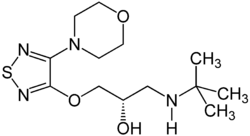- Timolol
-
Strukturformel 
Allgemeines Freiname Timolol Andere Namen - (–)-(S)-1-(tert-Butylamino)- 3-(4-morpholino-1,2,5-thiadiazol- 3-yloxy)propan-2-ol
- Latein: Timololum
Summenformel C13H24N4O3S CAS-Nummer - 26839-75-8
- 26921-17-5 (Monosalz der Maleinsäure)
PubChem 33624 ATC-Code DrugBank DB00373 Kurzbeschreibung kristalliner Feststoff [1]
Arzneistoffangaben Wirkstoffklasse Wirkmechanismus nichtselektiver β-Adrenozeptor-Antagonist
Verschreibungspflichtig: ja Eigenschaften Molare Masse 316,42 g·mol−1 Schmelzpunkt 71,5–72,5°C [1]
pKs-Wert 9,21 [2]
Löslichkeit wenig löslich in Wasser (2740 mg·l−1 bei 25 °C) [3]
Sicherheitshinweise Bitte beachten Sie die eingeschränkte Gültigkeit der Gefahrstoffkennzeichnung bei Arzneimitteln GHS-Gefahrstoffkennzeichnung [4] Maleat


Achtung
H- und P-Sätze H: 302-361 EUH: keine EUH-Sätze P: 281 [4] EU-Gefahrstoffkennzeichnung [4]
Xn
Gesundheits-
schädlichR- und S-Sätze R: 22-63 S: 36 LD50 Soweit möglich und gebräuchlich, werden SI-Einheiten verwendet. Wenn nicht anders vermerkt, gelten die angegebenen Daten bei Standardbedingungen. Timolol ist ein chiraler, enantiomerenreiner Arzneistoff aus der Gruppe der Betablocker und wird vor allem in Augentropfen zur Behandlung des Offenwinkelglaukoms (Grüner Star) eingesetzt.
Inhaltsverzeichnis
Pharmakologie
Timolol gehört zu der Gruppe der nichtselektiven Betablocker, da es nicht spezifisch an den β1-Adrenozeptoren bindet. Es weist keine intrinsische sympathomimetische Aktivität (ISA) auf. Das Timolol hemmt die β2-Adrenozeptoren des Ziliarkörpers des Auges und senkt daher die Produktion des Kammerwassers. Durch die verminderte Kammerwasserbildung kommt es zu Senkung des Augeninnendruckes. Die relative Wirkstärke des Timolol im Vergleich zum Propranolol beträgt 6.
Pharmakokinetik
Das fettlösliche Timolol wird nach oraler Aufnahme gut resorbiert, die Bioverfügbarkeit des Timolols beträgt etwa 50 bis 60 %. Die Plasmahalbwertszeit vom Timolol beträgt etwa 4 bis 5 Stunden. Es wird bis zu 80 % in der Leber metabolisiert. Die Plasmaproteinbindung des Timolol beträgt 60 %. Das Timolol wird in der Niere zu 30 % ausgeschieden.
Synthese
Es gibt mehrere Synthesewege für Timolol. Ausgehend von 3,4-Dichlor-1,2,5-thiadiazol und Morpholin wird in einem fünfstufigen Verfahren zunächst racemisches Timolol erzeugt. Die Racematspaltung mit (+)-Weinsäure liefert dann (S)-Timolol, das als Arzneistoff eingesetzt wird. Alternativ kann enantiomerenreines Timolol auch aus D-Glycerinaldehyd – unter Vermeidung einer Racematspaltung – hergestellt werden.[5]
Literatur
- T. Karow / R. Lang-Roth: Allgemeine und spezielle Pharmakologie und Toxikologie. (2003) S. 62–66
- G. Herold: Innere Medizin (2004)
Einzelnachweise
- ↑ a b Thieme Chemistry (Hrsg.): Römpp Online. Version 3.1. Georg Thieme Verlag, Stuttgart 2007.
- ↑ a b Timolol. In: DrugBank.
- ↑ Timolol bei ChemIDplus.
- ↑ a b c Datenblatt Timolol maleate salt bei Sigma-Aldrich, abgerufen am 24. April 2011.
- ↑ Axel Kleemann, Jürgen Engel, Bernd Kutscher und Dieter Reichert: Pharmaceutical Substances, 4. Auflage (2000) 2 Bände erschienen im Thieme-Verlag Stuttgart, S. 2043−2045, ISBN 978-1-58890-031-9; seit 2003 online mit halbjährlichen Ergänzungen und Aktualisierungen.
Handelsnamen
Arutimol (D), Betimol (A), Chibro-Timoptol (D), Dispatim (D), NyoGel (D), Nyolol (CH), zahlreiche Generika (D)
AZARGA (A), Combigan (D, CH), Cosopt (D, CH), DuoTrav (D, CH), Fotil (D), Ganfort (D, CH), TP-Ophtal (D), Xalacom (D, CH)

Bitte den Hinweis zu Gesundheitsthemen beachten! Kategorien:- ATC-C07
- ATC-S01
- Gesundheitsschädlicher Stoff
- Stoff mit Verdacht auf reproduktionstoxische Wirkung
- Thiazol
- Morpholin
- Beta-Aminoalkohol
- Ether
- Arzneistoff
- Betablocker
Wikimedia Foundation.
